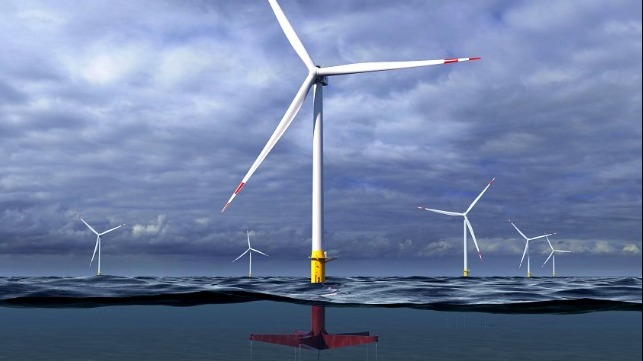Developing Large Floating Offshore Wind to Increase Power Generation

Efforts are underway to develop a new generation of floating wind turbines that would enable larger and more powerful installations that would dramatically expand the range for offshore wind power generation. The goal of the effort is to make it possible to go beyond the current limits of fixed-bottom installations to lower the cost of installing larger, more powerful floating wind turbines beyond the current dept limits.
GE researchers provided details of an ongoing two-year, $4 million research project through the ARPA-E’s ATLANTIS (Aerodynamic Turbines Lighter and Afloat with Nautical Technologies and Integrated Servo-control) program to design and develop advanced controls to support a 12 MW floating offshore wind turbine. GE is partnering on the project with Glosten, the developer of the PelaStar tension-leg platform floating wind turbine foundation.
“With GE’s Haliade-X, the world’s most powerful offshore wind turbine built to date, we’re just beginning to tap into the future promise of offshore wind power in Europe, the US, and other parts of the globe,” said Rogier Blom, a Senior Principal Engineer in Model-Based Controls and the project’s principal investigator. “Today, these fixed-bottom wind turbines are limited to depths of 60 meters or less. With floating turbines, we would be able to dramatically expand the reaches of offshore wind power to areas with water depths of 60 meters or greater.”
Accelerating the development of new technologies to promote the future of floating offshore wind energy is the key objective of ARPA-E’s Atlantis program. By coupling a 12 MW GE turbine with Glosten’s tension leg platform technology, the team is seeking to address the challenge of designing a lightweight floating turbine with up to 35 percent less mass in the tower and the floating platform. This is expected to result in a very significant reduction of the resulting Levelized Cost of Energy – LCOE – of the electricity generated with this turbine.
Bloom notes though that the enormity of building a floating platform that can support a structure as massive as an 850-plus foot offshore turbine cannot be understated.

that matters most
Get the latest maritime news delivered to your inbox daily.
“Designing a floating turbine is like putting a bus on a tall pole, making it float and then stabilizing it while it interacts with wind and waves. Doing this well is both a design and controls challenge,” said Bloom. “Through our ATLANTIS project with ARPA-E, we will be concurrently designing the controls system with the design of the floating structure itself to advance Floating Offshore Wind Energy toward becoming a future commercially viable solution.”
Enabling the next generation of floating offshore wind turbines would dramatically expand the power generation potential of offshore wind power. The National Renewable Energy Lab (NREL), estimates that the introduction of floating turbines would expand the potential of U.S. offshore wind resources to more than 7,000 TeraWatt hours (TWhs) per year, nearly double the total annual US energy consumption of 4,000 TWh.
